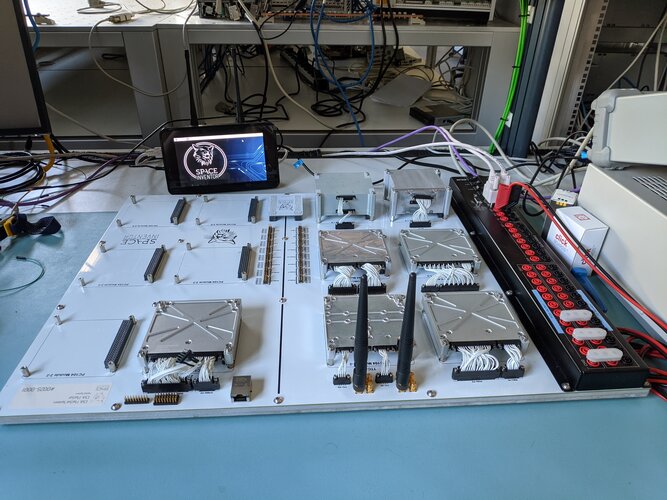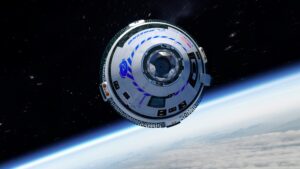Dwarf galaxy catches globular cluster
Wednesday, 20 October 2021 09:56 Astronomers already knew that our own Milky Way grew by taking in smaller galaxies. But now a team of Italian-Dutch researchers have shown that a small galaxy neighbouring the Milky Way has in turn absorbed an even smaller galaxy from its vicinity. The researchers will publish their findings on Monday in the journal Nature Astronomy.
According to the prevailing theory, large galaxies such
Astronomers already knew that our own Milky Way grew by taking in smaller galaxies. But now a team of Italian-Dutch researchers have shown that a small galaxy neighbouring the Milky Way has in turn absorbed an even smaller galaxy from its vicinity. The researchers will publish their findings on Monday in the journal Nature Astronomy.
According to the prevailing theory, large galaxies such Ten years of Soyuz at Europe’s Spaceport
Wednesday, 20 October 2021 09:31
On 21 October 2011, the first pair of Galileo navigation satellites was launched by a Russian-built Soyuz rocket from Europe’s Spaceport in French Guiana.
Opened-out ‘FlatSat’ for CubeSat testing
Wednesday, 20 October 2021 08:30
ESA’s latest CubeSat mission is destined to never leave the ground. Instead it is doing its duty as an opened-out ‘FlatSat’ – with its interlinked subsystems spread out across a table at the Agency’s Data Systems and Microelectronics Laboratory at its ESTEC technical centre in the Netherlands.
Calm above the storm
Wednesday, 20 October 2021 06:38 Image:
Image:
Auroras make for great Halloween décor over Earth, though ESA astronaut Thomas Pesquet snapped these green smoky swirls of plasma from the International Space Station in August. Also pictured are the Soyuz MS-18 “Yuri Gagarin” (left) and the new Nauka module (right).
The Station saw quite some aurora activity that month, caused by solar particles colliding with Earth’s atmosphere and producing a stunning light show.
Fast forward to October and space is quite busy.
On 9 October the Sun ejected a violent mass of fast-moving plasma into space that arrived at Earth a few days later. The coronal mass ejection (CME)
Boeing aims for unmanned Starliner test flight in first half of 2022
Wednesday, 20 October 2021 06:04
Boeing is aiming for a test flight of its unmanned CST-100 Starliner capsule in the first half of next year and a potential launch of its crewed spacecraft at the end of 2022, company officials said Tuesday.
The CST-100 had been scheduled to fly to the International Space Station (ISS) from Cape Canaveral, Florida, on August 3 but the flight was aborted just hours before launch because of problems with propulsion system valves.
Boeing officials told reporters in a briefing on Tuesday that they were still conducting testing of the valves but they may heve become stuck because of moisture or condensation.
"Normal environment humidity was likely the source of that moisture in the valves," Michelle Parker, Boeing Space and Launch chief engineer, said.
NASA supports Boeing as Starliner valve investigation continues
Wednesday, 20 October 2021 00:08
NASA continues to stand behind Boeing as the company works to resolve a valve problem with its CST-100 Starliner that will push back operational missions of the commercial crew vehicle into 2023.
LeoLabs to construct radars in Western Australia
Tuesday, 19 October 2021 23:00
LeoLabs announced plans Oct. 19 to construct two phased-array radars in Western Australia, the sixth site for the Silicon Valley startup’s global space-tracking network.
Industry panel: U.S. space systems need protection against cyber attacks
Tuesday, 19 October 2021 19:06
The U.S. government does not technically consider space systems “critical infrastructure,” which is slowing down efforts to protect networks from cyber attacks, experts said.
Cloudy timelapse over Baja California
Tuesday, 19 October 2021 19:00 Video:
00:02:26
Video:
00:02:26
Timelapse video made during ESA astronaut Thomas Pesquet’s second mission to the International Space Station, “Alpha”. The camera is setup to take pictures at intervals of two a second, and the pictures are then edited into this video that plays at 25 pictures a second. The video is around 12 times faster than real speed.
Thomas shared this video on social media with the caption:
“Soar over Earth for timelapse Tuesday: clouds, clouds, Baja California, and more clouds. There are often many clouds covering our planet!”
Over 200 experiments are planned during Thomas’ time in space, with 40 European ones
Kleos Space orders reconnaissance satellites for 2022 launch
Tuesday, 19 October 2021 18:39
Luxembourg-based startup Kleos Space has ordered four more RF reconnaissance satellites, securing a launch in mid-2022 to improve data collection and revisit times.
Humans to blame for warming lakes
Tuesday, 19 October 2021 13:20
While the climate crisis is, unfortunately, a reality, it is all too easy to assume that every aspect of our changing world is a consequence of climate change. Assumptions play no role in key environmental assessments and mitigation strategies such as we will see in the upcoming UN climate change COP-26 conference – it’s the science and hard facts that are critical. New research published this week is a prime example of facts that matter. Using model projections combined with satellite data from ESA’s Climate Change Initiative, this latest research shows that the global rise in the temperature of
Back to gravity: Russians talk about world's 1st space movie
Tuesday, 19 October 2021 12:53
Germany’s Exolaunch expands overseas for larger share of U.S. launch market
Tuesday, 19 October 2021 12:37
German launch services provider Exolaunch is expanding to the U.S. in search of a greater share of the rapidly growing market, stepping up competition against Seattle-based rideshare broker Spaceflight.
Senate appropriators direct NASA to select second Artemis lunar lander
Tuesday, 19 October 2021 10:42
Senate appropriators want NASA to select a second company for its program to develop crewed lunar landers, but provided the agency with only a small increase in funding to support that.
A Chinese satellite is now active weeks after an anomaly during launch
Tuesday, 19 October 2021 10:30
The classified Chinese satellite Shiyan-10 is now active, nearly three weeks after suffering an anomaly during launch that appeared to result in the loss of the spacecraft.

